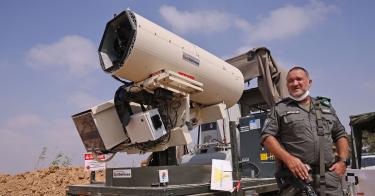In response to increasing missile threats from regional terrorist groups, Israeli Prime Minister Naftali Bennett announced that a new laser defense system will be deployed within a year to intercept incoming missile attacks. This news highlights the increasing pace of development and utility of using high-energy lasers—a directed energy weapon—for missile defense.
Israel already deploys traditional missile defense systems that fire interceptors to destroy an incoming target with the force of impact. For instance, Israel’s Iron Dome, co-developed with the U.S., played a critical role in intercepting thousands of rockets launched by Hamas in a conflict last May. But despite Iron Dome’s high success rate, it is not the most cost-effective method of defense. For each $300-to-$800 rocket Hamas fires, Israel must spend at least $40,000 to intercept each rocket.
That’s why Israel’s new laser system, referred to as the “Iron Beam” project, could provide a cost-effective way to bolster Israel’s preexisting missile defenses. Rather than using kinetic energy to intercept a missile, directed energy weapons would use a condensed beam of electromagnetic energy—like a laser—to destroy an incoming target.
Fielding these weapons may require a high investment up front, but once deployed, could intercept short-range missile and rocket threats for a small percentage of the price-per-shot of traditional missile interceptors.
Israel has already successfully tested an air-based laser system that can intercept drones. Now, Israel’s Iron Beam program would use ground-based defenses to intercept ballistic missiles. This will be more technologically challenging, but could have significant payoff if successful.
For Israel, directed energy weapons will play an important role in defending against the ongoing missile threats it faces on a daily basis. But directed energy can make a significant contribution to U.S. missile defenses as well.
Despite high initial cost, directed energy excels in providing cost-effective, asymmetric defense against large volleys or swarms of missile launches. This is the kind of threat the U.S. will need to worry about in a conflict with China.
In the Indo-Pacific, China has invested heavily in ballistic and cruise missiles that can hold at risk our bases and aircraft carriers in the region. China is also developing hypersonic missiles that travel more than five times the speed of sound and could penetrate our existing missile defenses.
Beijing’s offset strategy seems to entail overwhelming U.S. ships and other assets with its large missile arsenal, one that could force the United States to spend a lot of money on existing missile interceptors with unit prices in the millions.
To be clear, continued procurement of existing missile interceptors like the Standard Missile-3 remains critical to the competition with China. But using directed energy weapons as a complement to our existing systems could provide a way to flip the cost-benefit ratio in our favor. If successfully integrated into our current missile defense architecture, they could improve our capacity to stay ahead of these threats, making the high up-front costs worth it.
Fortunately, the U.S. is already developing multi-domain directed energy systems to shoot down drones, unmanned aerial vehicles, and other short-range systems. But directed energy for missile defense could use a boost.
In last year’s defense policy law, Congress returned authority for directed energy to the Missile Defense Agency with the instruction to prioritize directed energy investment. As global missile threats continue to advance, the push for this technology should continue in order to aid in our efforts to deny adversaries a technological advantage.
Time will tell if Israel’s laser defense system will come to fruition. But the promise of advanced missile defense technologies is clear, and the U.S. must ensure it does not miss a potential game-changing opportunity.
This piece originally appeared in The Daily Signal




